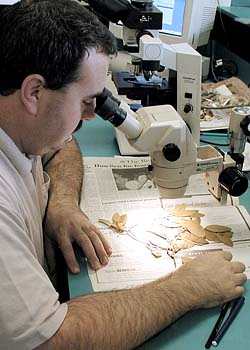How to identify specimens

How to collect specimens
Use our step-by-step guide on how to collect plants and send botanical specimens.
There is also a quick guide on how to collect and send botanical specimens for identification and incorporation into the Queensland Herbarium collections.
Some important points:
- Before you collect, make sure you have permission from the landowner.
- You’ll need a permit to collect native plants on public land.
- If you want to collect lichens, fungi or algae, ask us about their specific collecting requirements.
Botanical specimens have to be flowering/fruiting and of the required size (30cm), and should be presented pressed and dried in folders of newspaper.
Once prepared post them to us. Please include a completed submission sheet with each specimen.
How to get species maps and data
The Australasian Virtual Herbarium provides specimen label information and species distribution maps for Queensland collections.
Public reference centre
Our public reference centre is available for students and members of the public to identify their own plant specimens 9am – 5pm Monday to Friday.
Plant identification is aided by a reference set of plant specimens, a range of printed guides, published floras, identification tools and microscope access.
Online tools for identifying plants
Please note: These sites are aimed at technical users.
- KeyBase – online keys including projects on
- Some other relevant keys (not on KeyBase):
- Online floras (Australia and neighbouring states):
Botanical services
The Queensland Herbarium provides plant identification services, information and advice on Queensland’s plant species and vegetation. This can include information on species’ distributions, weediness and conservation status. For horticultural advice, we recommend contacting your local nursery or botanic gardens.
Plant identification and information services are free to the general public for up to 3 fresh, or 10 pressed and dried specimens in any one submission.
Plant identification services are available between 10am and 2pm Monday to Friday of each week, however specimens will still be received outside of these hours.
If you are a commercial client, contact us for a full list of services and charges. Commercial clients are limited to no more than 20 specimens in any one submission unless prior arrangements have been made.
Botanical information is used by:
- governments, landowners and businesses―for planning and management
- non-government organisations―for conservation and management
- home owners―to discover what plants are native, poisonous or weedy.